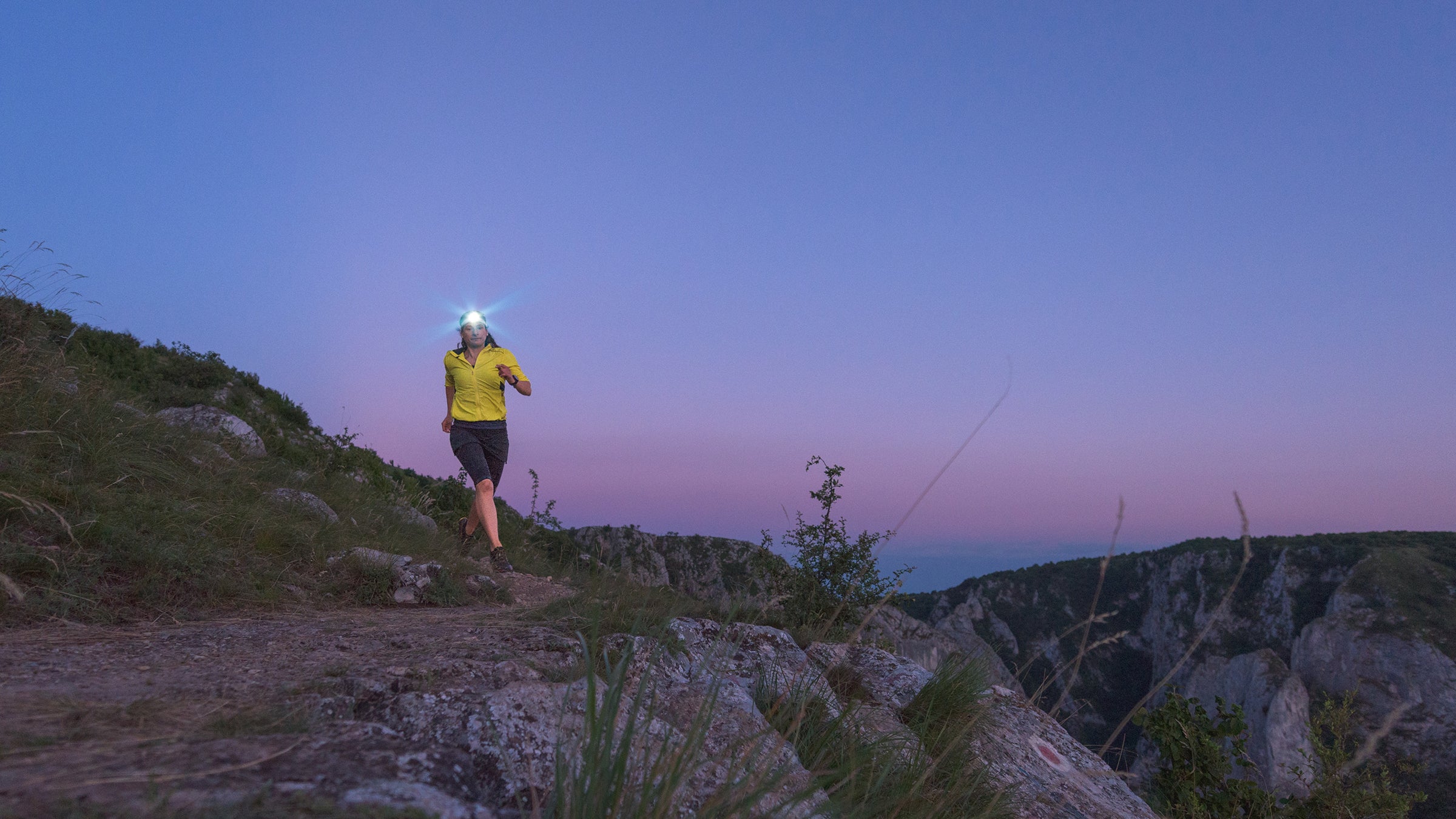Humans are not naturally nocturnal, but we are nonetheless very adaptive creatures and, with the right gear and knowledge, can almost turn night into day. Just as our eyes adapt when we go from light to dark, gaining a comfort level with night running is something that takes time and improves as we get used to it.
Pace and Pavement
Aliza Lapierre, a Vermont ultrarunner, says that she has learned to accept that her night running pace is going to be slower, especially when trail running on technical terrain. “Forcing my speed on a trail in the dark, trying to hit paces that I would hit during the day has just led to frustration and falls,” she says. “You can still run hard, but I recommend running by effort, especially at night, and forget about the numbers your watch is telling you.”
Because of the lack of light and the shadows cast by head, body or hand-held lighting, finding one’s footing, especially on trails, requires some familiarity before gaining confidence and being able to feel your way around obstacles. For that reason, it is common for novice and experienced nocturnal runners alike to gravitate toward roads.
Mario Mendoza, an ultrarunner who does most of his training in Bend, Oregon, tends to stick to neighborhood roads at night because of safety. “If I go on trail it needs to be double wide and open space,” he says. “I know people who have seen mountain lions.”
For running roads at night reflectivity and a rear blinking light are crucial safety measures. “On the roads make sure you can easily be seen from all directions. This means being able to see and be seen,” advises Lapierre. “I recommend having both a headlamp and reflective gear. Whether you wear a reflective vest or have clothing that has reflective components in it.”

Unexpected Encounters
Even experienced runners can find navigating at night exponentially more difficult. And, it can lead to scary situations. In Hal Koerner’s Field Guide to Ultrarunning, Koerner describes an animal encounter while he was attempting the fastest known time on the Colorado Trail and got lost a few hours before sunrise. He was emerging from the woods, into an open area, when he was suddenly confronted by dozens of glowing eyes. Not only were they focused on him but they were rapidly approaching. “I had no idea what they belonged to or where to go,” Koerner said. “Should I try to outrun them? Judging from the sound of rustling limbs and heaving breath, they were coming at an aggressive pace, and so I picked up mine as well, heart beating in my throat.” Finally, Koerner realized they were a herd of cows in a pasture where they wandered freely and the rancher often showed up early in the morning hours to feed them.
The point is that everything looks and feels different at night. Expect to be startled, confused and sometimes frightened, and that’s before you start to encounter the tiredness and even mild hallucinations that can complicate night running.
Sleep Routines
We are wired to be sleeping during the dark, so running at that time can mess with sleep patterns. But it doesn’t have to. “Despite having to focus and be tuned in, I seem to sleep well after a night run,” says Lapierre. “I stick to my normal routine before bed even after a night run and that seems to let my body know that, despite just exercising, it is time to settle and rest.”
Mendoza says that if he does a hard effort at night it definitely messes with his sleep, but that easy runs don’t. One lesson Mendoza learned when running overnight is that he gets hit by waves of tiredness. “I assumed when running the adrenaline would just keep me awake and it does, to a certain extent, but I still get those waves of sleepiness.”
He advises those wanting to run at night to stick to a routine as much as possible. “So if you’re doing 2-3 night runs a week I’d try to do them at the same time so your body learns to make the most out of it. I would also advise doing night runs before 10pm, if possible, so getting to sleep is easier.”
Food Strategies
Running late requires different strategies on timing your food as well. Mendoza likes to eat a good meal after running late, so he keeps it light before. “Up till like 5 p.m. my eating is the same and then I am cautious so that I’m not full,” he says. His pre-run dinner “is carbs and stuff that is easy to digest.” Then he eats protein after the run.
As far as eating while running at night, Lapierre finds that because her pace is typically slower in the dark, she consumes fewer calories. “I personally let my stomach and energy levels guide me, but in general would say I consume about 100 less calories per hour in the dark then daylight.”
Lapierre understands that night running can seem daunting and raises many questions like ‘what to wear?,’ ‘where to go?,’ and ‘is it safe?’ But all can be overcome by taking it easy and adapting to the new environment and experiences. She recommends that those uncomfortable with nocturnal jaunts invite a friend to share those first steps. And, she says, it is worth it. “It’s amazing sharing the experience with another person or alone, so I hope everyone at least tries it once,” Lapierre says.


